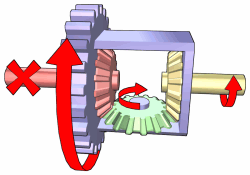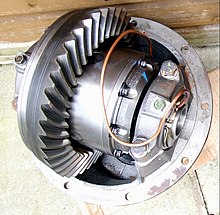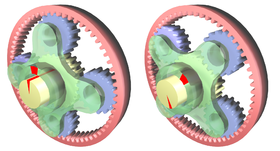Differential (mechanical device): Difference between revisions
| Line 117: | Line 117: | ||
A miter-gear differential used for analog computing is shown at <http://www.tpub.com/content/engine/14037/css/14037_79.htm> |
A miter-gear differential used for analog computing is shown at <http://www.tpub.com/content/engine/14037/css/14037_79.htm> |
||
<references/> |
<references/> |
||
lol |
|||
== External links == |
== External links == |
||
Revision as of 13:42, 12 June 2008
- This article deals with the concept of a differential in mechanics. For other meanings of "differential" see differential.



Differentials are a variety of gearbox, almost always used in one of two ways. In one of these, it receives one input and provides two outputs; this is found in every automobile. In the other, less commonly encountered, it combines two inputs to create an output that is the sum (or difference) of the inputs.
In an automobile and other wheeled vehicles, the differential allows each of the driving wheels to rotate at different speeds, while supplying equal torque to each of them. In automotive applications, the differential and its housing are sometimes collectively called a "pumpkin" (because the housing resembles a pumpkin).
Purpose
A vehicle's wheels rotate at different speeds, especially when turning corners. The differential is designed to drive a pair of wheels with equal force, while allowing them to rotate at different speeds. In vehicles without a differential, such as karts, both driving wheels are forced to rotate at the same speed, usually on a common axle driven by a simple chain-drive mechanism. When cornering, the inner wheel travels a shorter distance than the outer wheel, resulting in the inner wheel spinning and/or the outer wheel dragging. This results in difficult and unpredictable handling, damage to tires and roads, and strain on (or possible failure of) the entire drive train.
Railroad locomotive and car wheels do not have differentials; wheels are fastened to the axle. This means that wheels have to slip when moving on curved tracks. On sharp curves, such as those for mass transit, wheel slippage can be very noisy.
History
There are many claims to the invention of the differential gear, but it is likely that it was known, at least in some places, in ancient times. Here are some of the milestones in the history of this device.
- 1050 BC-771 BC: The Book of Song claimed the South Pointing Chariot, which uses a differential gear, was invented during the Western Zhou Dynasty.
- 150 BC - 100 BC - The Antikythera mechanism, discovered on an ancient shipwreck near the Greek island of Antikythera, was once believed to employ a differential gear. This has since been disproved.
- 227 - 239 AD - Despite doubts from fellow ministers at court, Ma Jun from the Kingdom of Wei in China invents the first historically verifiable South Pointing Chariot, which provided cardinal direction as a non-magnetic, mechanized compass.
- 658, 666 AD - two Chinese Buddhist monks and engineers create South Pointing Chariots for Emperor Tenji of Japan.
- 1027, 1107 AD - Documented Chinese reproductions of the South Pointing Chariot by Yan Su and then Wu Deren, which described in detail the mechanical functions and gear ratios of the device much more so than earlier Chinese records.
- 1720 - Joseph Williamson uses a differential gear in a clock.
- 1810 - Rudolph Ackermann of Germany invents a four-wheel steering system for carriages, which some later writers mistakenly report as a differential.
- 1827 - modern automotive differential patented by watchmaker Onésiphore Pecqueur (1792-1852) of the Conservatoire des Arts et Métiers in France for use on a steam car. Sources: Britannica Online and [1]
- 1832 - Richard Roberts of England patents 'gear of compensation', a differential for road locomotives.
- 1876 - James Starley of Coventry invents chain-drive differential for use on bicycles; invention later used on automobiles by Karl Benz.
- 1897 - first use of differential on an Australian steam car by David Shearer.
- 1913 - Packard introduces the spiral-gear differential, which cuts gear noise.
- 1926 - Packard introduces the hypoid differential, which enables the propeller shaft and its hump in the interior of the car to be lowered.
Functional description

The following description of a differential applies to a "traditional" rear or front-wheel-drive car or truck: Power is supplied from the engine, via the gearbox, to a driveshaft (British term: propeller shaft), which runs to the drive axle. A pinion gear at the end of the propeller shaft is encased within the differential itself, and it engages with the large ring gear (British term: crownwheel), shown in the diagrams. The ring gear is attached to a carrier, which holds a set of three small planetary gears. The three planetary gears are set up in such a way that the two outer gears (the side gears) can rotate in opposite directions relative to each other. The pair of side gears drive the axle shafts to each of the wheels. The entire carrier rotates in the same direction as the ring gear, but within that motion, the side gears can counter-rotate relative to each other. The cluster of planetary gears and the side gears is sometimes referred to, collectively, as a spider.
(The term "planetary (or planet) gear" comes from the epicyclic arrangement, described later in this article. In an epicyclic differential, the planet gear(s) surround the sun gear.)
Thus, for example, if the car is making a turn to the right, the main ring gear may make 10 full revolutions, and during that time, the left wheel will travel more revolutions because it has further to travel, and the right wheel will travel fewer revolutions correspondingly, as it has less distance to travel. The side gears will turn in opposite directions relative to each other by, say, 2 full turns each (4 full turns with regard to each other), resulting in the left wheel making 12 revolutions, and the right wheel making 8 revolutions.
When the vehicle is traveling in a straight line, there will be no differential movement of the planetary system of gears other than the minute movements necessary to compensate for slight differences in wheel diameter, undulations in the road (which make for a longer or shorter wheel path), etc.
Loss of traction
One undesirable side effect of a differential is that it can reduce overall torque - the rotational force which propels the vehicle. The amount of torque required to propel the vehicle at any given moment depends on the load at that instant - how heavy the vehicle is, how much drag and friction there is, the gradient of the road, the vehicle's momentum and so on. For the purpose of this article, we will refer to this amount of torque as the "threshold torque".
The torque on each wheel is a result of the engine and transmission applying torsion, a twisting force, against the resistance of the traction at that wheel. Unless the load is exceptionally high, the engine and transmission can usually supply as much torque as necessary, so the limiting factor is usually the traction under each wheel. It is therefore convenient to define traction as the amount of torque that can be generated between the tire and the ground before the wheel starts to slip. If the total traction under all the driven wheels exceeds the threshold torque, the vehicle will be driven forward; if not, then one or more wheels will simply spin.
To illustrate how a differential can limit overall torque, imagine a simple rear-wheel-drive vehicle, with one rear wheel on asphalt with good grip, and the other on a patch of slippery ice. With the load, gradient, etc., the vehicle requires, say, 2000 Nm of torque to move forward (i.e. the threshold torque). Let us further assume that the non-spinning traction on the ice equates to 400 Nm, and the asphalt to 3000 Nm.
If the two wheels were driven without a differential, each wheel would push against the ground as hard as possible. The wheel on ice would quickly reach the limit of traction (400 Nm), but would be unable to spin because the other wheel has good traction. The traction of the asphalt plus the small extra traction from the ice exceeds the threshold requirement, so the vehicle will be propelled forward.
With a differential, however, as soon as the "ice wheel" reaches 400 Nm, it will start to spin, and then develop less traction ~300Nm. The planetary gears inside the differential carrier will start to rotate because the "asphalt wheel" encounters greater resistance. Instead of driving the asphalt wheel with more force, the differential will allow the ice wheel to spin faster, and the asphalt wheel to remain stationary, compensating for the stopped wheel by extra speed of the spinning ice wheel. The torque on both wheels will be the same - limited to the lesser traction of 300 Nm each. Since 600 Nm is less than the required threshold torque of 2000 Nm, the vehicle will not be able to move.
An observer will simply see one stationary wheel and one spinning wheel. It will not be obvious that both wheels are generating the same torque (i.e. both wheels are in fact pushing equally, despite the difference in rotational speed). This has led to a widely held misconception that a vehicle with a differential is really only "one-wheel-drive". In fact, a normal differential always provides equal torque to both driven wheels (unless it is a locking, torque-biasing, or limited slip type).
When changing the differential, it is essential to track your mileage to find the optimum time to add newer fluid. Relying on the look and smell of a differential can in many circumstances be misleading and incorrect. Consumers should also be aware that many vehicles feature differentials with oil that should never need to be replaced. Differential oil is generally a hypoid synthetic, but the owners manual should always be consulted.
Traction-adding devices
There are various devices for getting more usable traction from vehicles with differentials.

- One solution is the limited slip differential (LSD), the most well-known of which is the clutch-type LSD. With this differential, the side gears are coupled to the carrier via a stack of clutch plates which limits the speed difference between the two wheels.
- A locking differential employs a mechanism for allowing the planetary gears to be locked relative to each other, causing both wheels to turn at the same speed regardless of which has more traction; this is equivalent to removing the differential entirely.
- The torsen differential keeps sending some torque to the wheel with more resistance
- Electronic traction control systems usually use the ABS system to detect a spinning wheel and apply the brake to that wheel. This progressively raises the reaction torque at that wheel, and the differential compensates by transmitting more torque through the other wheel - the one with better traction.
- A viscous coupling unit can replace a center differential entirely or be used to limit slip in a normal differential. It works on the principle of allowing the two output shafts to counter-rotate relative to each other within a viscous fluid. The fluid allows slow relative movements of the shafts, such as those caused by cornering, but will strongly resist high-speed movements, such as those caused by a single wheel spinning.
A four-wheel-drive vehicle will have at least two differentials (one for each pair of wheels) and possibly a center differential to apportion power between the front and rear axles. In many cases (eg. Lancia Delta Integrale, Porsche 964 Carrera 4 of 1989 [2]) the center differential is an epicyclic differential to divide the torque asymmetrically between the front and rear axle. Vehicles without a center differential should not be driven on dry, paved roads in four wheel drive mode, as small differences in rotational speed between the front and rear wheels cause a torque to be applied across the transmission. This phenomenon is known as "wind-up" and can cause damage to the transmission or drive train. On loose surfaces these differences are absorbed by the tire slippage on the road surface.
A transfer case may also incorporate a center differential, allowing the drive shafts to spin at different speeds. This permits the four-wheel-drive vehicle to drive on paved surfaces without experiencing "wind-up".
Epicyclic differential
An epicyclic differential uses epicyclic gears to split torque asymmetrically between the front and rear axles. An epicyclic differential is at the heart of the Toyota Prius automotive drive train, where it interconnects the engine, motor-generators, and the drive wheels (which have a second differential for splitting torque as usual). It has the advantage of being relatively compact along the length of its axis (that is, the sun gear shaft).
In the image, the yellow shaft carries the sun gear, which is gray and almost hidden. The blue gears are called planet gears.

Spur-gear differential
This is another type of differential that was used in some early automobiles, more recently the Oldsmobile Toronado, as well as other non-automotive devices. It consists of spur gears only.
A spur-gear differential has two equal-sized spur gears, one for each half-shaft, with a space between them. Instead of the miter gear assembly (the "spider") at the center of the differential, there is a rotating carrier on the same axis as the two shafts. Power from a prime mover or transmission, such as the drive shaft of a car, rotates this carrier.
Mounted in this carrier are one or more pairs of identical pinions, generally longer than their diameters, and typically smaller than the spur gears on the individual half-shafts. Each pinion pair rotates freely on pins supported by the carrier. Furthermore, the pinions pairs are displaced axially, such that they mesh only for the part of their length between the two spur gears. The remaining length of a given pinion meshes with the nearer spur gear on its axle. Therefore, each pinion couples that spur gear to the other pinion, and in turn, the other spur gear.
When the drive shaft rotates the carrier, its relationship to the gears for the individual wheel axles is the same as that in a miter-gear differential.
Non-automotive applications

A differential gear train can also be used to give the difference between two input axles. Mills often used such gears to apply torque in the required axis. It's also used in fine mechanical watches with a hand to show the amount of reserve power in the mainspring.
The oldest known example of a differential was once thought to be in the Antikythera mechanism. It was supposed to have used such a train to produce the difference between two inputs, one input related to the position of the sun on the zodiac, and the other input related to the position of the moon on the zodiac; the output of the differential gave a quantity related to the moon's phase. It has now been proven that the assumption of the existence of a differential gearing arrangement was incorrect.[1]
In the first half of the twentieth century, mechanical analog computers, called differential analyzers, were constructed that used differential gear trains to perform addition and subtraction. The U.S. Navy Mk.1 gun fire control computer used about 160 differentials of the miter gear type.
Active differentials
A relatively new technology is the electronically-controlled active differential. A computer uses inputs from multiple sensors, including yaw rate, steering angle, and lateral acceleration and adjusts the distribution of torque to compensate for undesirable handling behaviors like understeer. Active differentials used to play a large role in the World Rally Championship, but in the 2006 season the FIA has limited the use of active differentials only to those drivers who have not competed in the World Rally Championship in the last five years.
Fully integrated active differentials are used on the Ferrari F430 and on the rear wheels in the Acura RL.
The second constraint of the differential is passive – it is actuated by the friction kinematics chain through the ground. The difference in torque on the tires (caused by turns or bumpy ground) drives the second degree of freedom, (overcoming the torque of inner friction) to equalise the driving torque on the tires. The sensitivity of the differential depends on the inner friction through the second degree of freedom. All of the differentials (so called “active” and “passive”) use clutches and brakes for restricting the second degree of freedom, so all suffer from the same disadvantage – decreased sensitivity to a dynamically changing environment. The sensitivity of the computer controlled differential is also limited by the time delay caused by sensors and the response time of the actuators.
See also
References
A miter-gear differential used for analog computing is shown at <http://www.tpub.com/content/engine/14037/css/14037_79.htm>
- ^ Wright, M T. (2005). "The Antikythera Mechanism and the early history of the Moon Phase Display". Antiquarian Horology. 29 (3 (March 2006)): 319–329.
lol
External links
- "Around the Corner", 1937 Jam Handy film made for Chevrolet explains very clearly how a differential works.
